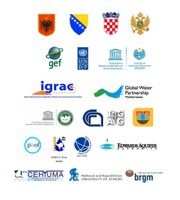Component 2
Outcome 2. The strengthened collective knowledge and coordination among development plans of countries, projects, agencies and donors, improves sustainability of the resource.
Component 2 of the DIKTAS Project refers to the establishment of cooperation among countries sharing the aquifer and is aiming at strengthening the collective knowledge and the coordination among development plans of countries, projects, agencies and donors, and to the improvement of the sustainability of the resource.
The Component will produce three main outputs.
One of the expected Outputs involves the establishment and operation of a multi-country consultative body for an improved management of the shared groundwater resource.
A consultative and information exchange (CIE) body of the four countries could be a first step along the way of a systematic commitment to joint management, and a first response to the call of the science community of the region that identified as key priority “... to gain a better mutual understanding of the peculiar properties and functions of the Dinaric Karst Aquifer System, and to adopt policies for its joint management, based on a regional consultative and management mechanism”.
Such cooperation is required by the provisions of the EU Water Framework Directive (WFD), which the four countries are in the process of implementing in their national legislations; the UNECE Water Convention (1992) which the DIKTAS countries have ratified or are in the process of ratifying; and by the UN General Assembly Resolution A/RES/63/124, which represents the only international text related specifically to transboundary aquifers.
In order to reach an agreement on the form of consultation and information exchange mechanism and its structure, operational modalities and level of participation, various options of multi-country cooperation will be reviewed. There are no cases however referring directly to Karstic systems, where the traditional distinction between groundwater and surface water looses meaning, and may even mislead overall water management approaches. The project will be a first step in this direction, and will strive to set a precedent of transboundary cooperation in a large karst province.
The other Output of Component 2 and 4th Output of the project would be the adoption by the project Countries of Environmental quality targets and the establishment of a joint harmonized monitoring program of the environmental status.
Once the TDA process will be concluded, the CIE, supported by the project, will review and adopt the Shared Vision for the DIKTAS (Output 2) and attempt to translate the proposed “…optimal desirable standards in terms of quality, priority uses, level of protection and integrity of dependent ecosystems” into environmental quality targets to be achieved in a agreed upon lapse of time. The set of Environmental Status Indicators and the modalities for periodic long term monitoring and data exchange will be submitted to the countries for approval and implementation.
The fifth Output of the Project, under Component 2 will aim at the establishment of a mechanism for coordination and exchanges with other relevant projects and initiatives.
Within the context of the CIE activities, the project facilitate contacts with all relevant initiatives in the specific country/region, and will help to capture the opportunities for synergies and establish a commitment to periodic consultations and exchanges of project personnel, electronic forums, meetings etc in order to avoid overlaps and repetitions.
Ongoing relevant projects


